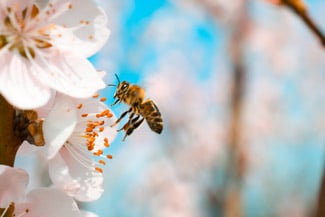Do bees know how to add and subtract?
 Bees have some new surprises in store for us! Having already proven that bees understand the concept of “zero,” the same team of scientists, from the Royal Institute of Technology at the University of Melbourne (Australia) and the CNRS Laboratory at the University of Toulouse III (France), recently showed that bees can also add and subtract. How were the researchers able to demonstrate the arithmetic skills of these insects?
Bees have some new surprises in store for us! Having already proven that bees understand the concept of “zero,” the same team of scientists, from the Royal Institute of Technology at the University of Melbourne (Australia) and the CNRS Laboratory at the University of Toulouse III (France), recently showed that bees can also add and subtract. How were the researchers able to demonstrate the arithmetic skills of these insects?A number of animals have been shown to have some understanding of numbers at a basic level. The scientific community makes a distinction between species that can discriminate quantities and those that use numerical (precise, symbolic) cognition. Numerical cognition requires a sophisticated level of knowledge, involving complex mental processing of numbers, long-term rules, and short-term working memory. Studies have shown that rhesus monkeys, parrots and even spiders are capable of adding and/or subtracting. When it comes to bees, they’ve already proven their ability to learn a certain number of rules and to distinguish between concepts such as “right/left,” "same/different,” or “bigger/smaller."
In this study, S.R. Howard and his colleagues trained 14 bees in order to further explore numerical cognition in these tiny brains. Specifically, the bees were trained to enter a Y-shaped maze where they were exposed to certain stimuli. At the entrance to the maze, the bee discovered a first visual stimulus: a set of symbols (between 1 and 5 "units"). These shapes were either blue (symbol for addition) or yellow (symbol for subtraction). After viewing this initial stimulus, the bee flew through a hole to the decision chamber where it had to decide whether to turn left or right. At the entrance to each path, there was a new stimulus: either an incorrect solution (which led to a path with bitter-tasting quinine), or the correct solution (which led to a food reward). The researchers randomized the side on which the correct answer appeared to avoid any position bias.
The purpose of the training was to teach the bees to apply the rules of addition (blue) or subtraction (yellow) and choose the correct result for each of these operations. For example, if the initial stimulus was three yellow squares, the bee would then have to choose between the entrance with three yellow squares or the entrance with two yellow squares (the correct answer). Conversely, if the initial stimulus was two blue squares, the bee had to choose the path entrance with three blue squares (versus one blue square) to obtain the sugar water.
After more than one hundred tries (4-7 hours of learning), the bees correctly identified that blue meant +1 and yellow meant -1. In the testing phase which followed, with 1 to 5 different shapes (square, diamond, circle, and triangle), the bees stopped receiving a reward (or sanction). In each of the tests, the insects chose the correct entrance at a statistically significant rate (choosing correctly between 60 and 75% of the time). The rules they learned were thus applied to new configurations (of numbers and shapes). In other words, the bees used arithmetic to solve unfamiliar problems.
This research on advanced numerical cognition in the tiny brains of bees tells us a lot about the capacities of different brain architectures and sizes.
Source: S.R. Howard, A. Avarguès-Weber, J. E. Garcia, A. D. Greentree & A. G. Dyer, “Numerical cognition in honeybees enables addition and subtraction”, in Science Advances, Feb. 2019







